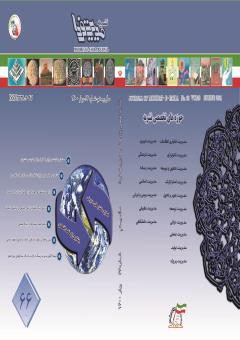Analysis of Factors Affecting Stock Selection Using Logarithmic Fuzzy Preference Programming Approach
Subject Areas : مدیریت صنعتی
Daryush Farid
1
,
َAbolfazl Dehghani firoozabadi
2
![]() ,
Davood Andalib Ardakani
3
,
hamidreza mirzaei
4
,
Davood Andalib Ardakani
3
,
hamidreza mirzaei
4
1 - Associate Professor, Department of Accounting and Finance, Faculty of Economics, Management and Accounting, Yazd University
2 - PhD student in financial management, Department of Accounting and Finance, Faculty of Economics, Management and Accounting, Yazd University
3 - PhD student in financial management, Department of Accounting and Finance, Faculty of Economics, Management and Accounting, Yazd University
4 - Assistant Professor, Department of Accounting and Finance, Faculty of Economics, Management and Accounting, Yazd University
Keywords: Stock market, stock portfolio, fuzzy logarithmic preference programming,
Abstract :
The stock market is especially important as a capital investment instrument both for the investor and for the investor. Stock markets are affected not only by large parameters but also by thousands of other factors. The high number and unknown factors affecting stock prices, as well as the complexity of the relationship between these factors and the stock price, have caused uncertainty in the field of investment. One of the tools to reduce uncertainty and the most important discussion of investing in the stock exchange is the selection of the stock portfolio optimally. In this study, through interviewing experts and reviewing existing documents, 6 main criteria for identifying the optimal stock portfolio selection were identified. Using logistic fuzzy preferential programming, weighing these criteria and, finally, weighting the indexes related to We defined each criterion. The results show that the criteria for profitability, efficiency and risk are the most important criteria in choosing stock portfolios
آذر، ع. معماریانی، ع. (1376). برنامه¬ریزی شولا تکنیکی نوین برای برنامه¬ریزان، نشریه علمی دانشگاه شاهد، شماره 9 و 10
آذر، ع. راموز، ن. عاطفه¬دوست، ع. (1391). کاربرد روش تخمین مجموعه غیرمرجح در انتخاب پرتفوی بهینه، فصلنامه علمی-پژوهشی تحقیقات مالی، شماره 14، 14-1.
اسلامي بيدگلي، غ. سارنج، ع. (1387). انتخاب پرتفوي با استفاده از سه معيار ميانگين بازدهي، انحراف معيار بازدهي و نقدشوندگي در بورس اوراق بهادار تهران، مجله بررسيهاي حسابداري و حسابرسی، شماره 53.
افشارکاظمی، م. خلیلی عراقی، م. سادات¬کیایی، ا. (1391). انتخاب سبد سهام در بورس اوراق بهادار تهران با تلفیق روش تحلیل پوششی داده¬ها و برنامه¬ریزی آرمانی، دانش مالی تحلیل اوراق بهادار، شماره 13، 63-49.
امیریان، س. امیری، م. (1392). تأثیر به¬کارگیری روش¬های چندشاخصه با رویکرد فازی بر بازدهی پرتفوی انتخابی در بورس اوراق بهادار تهران، دهمین کنفرانس بین المللی مهندسی صنایع، تهران، انجمن مهندسی صنایع ایران، دانشگاه صنعتی امیرکبیر.
انواری رستمی، ع. حسنیان، ش. رضایی اصل، م. (1391). رتبه¬بندی مالی شرکت¬های بورس اوراق بهادار تهران با استفاده از روش¬های تصمیم¬گیری چندشاخصه ومدل¬های ترکیبی، فصلنامه علمی-پژوهشی تحقیقات مالی، شماره 14(1)، 54-31.
بابایی، ص. قائمی، ا. (1391). ارائه یک مدل دوهدفه برای مشأاله انتخاب پرتفوی با در نظر گرفتن سنجه¬های ریسک مختلف، هشتمین کنفرانس بین المللی مهندسی صنایع، تهران: انجمن مهندسی صنایع ایران، دانشگاه صنعتی امیرکبیر.
بهنامیان. ج، مشرفی. م، (1396). ارائه الگوریتم ترکیبی برای بهینه¬سازی چندهدفه سبد سهام به وسیله برنامه¬ریزی فازی، مجله مهندسی مالی و مدیریت اوراق بهادار، شماره 30.
تهرانی، ر. (1391). مدیریت مالی، تهران، انتشارات نگاه دانش.
حامدیان، م. (1379). بررسی عوامل موثر بر قیمت سهام و تصمیم¬گیری سرمایه¬گذاران در بورس اوراق بهادار تهران، پایان¬نامه کارشناسی ارشد، دانشگاه شهید بهشتی.
دلبری، م. (1380). بررسی معیارهای مؤثر بر انتخاب سهام در بورس اوراق بهادر تهران بر اساس مدل فرآیند تحلیل سلسله مراتبی، پایان نامه کارشناسی ارشد، دانشگاه اصفهان.
راعی، ر. پویانفر، ا. (1387). مدیریت سرمای¬گذاری پیشرفته، تهران، انتشارات سمت.
شاه¬علیزاده، م. معماریانی، ع. (1382). چارچوب ریاضی گزینش سبد سهام با اهداف چندگانه، بررسی¬های حسابداری و حسابرسی، مجله مدیریت دانشکده دانشگاه تهران، شماره 32، ص 83-102.
میرغفوری، ح. (1388). کاربرد فرایند تحلیل سلسله مراتبی فازی در اولویت بندی عوامل مؤثر بر انتخاب سهام در بورس اوراق بهادار تهران از دیدگاه سهامداران، مجله توسعه و سرمایه، سال دوم، شماره3، ص 11-130.
K. Po-Chang and L. Ping-Chen. (2008). Resource allocation neural network in portfolio selection, Expert Systems with Applications, Vol. 35, Issues 1-2, July–August, pp. 330-337.
Mainik, G. Mitov, G and Rüschendorf,L. (2015). Portfolio optimization for heavy-tailed assets: Extreme Risk Index vs.
Markowitz, Journal of Empirical Finance.
Markowitz, H. (1952). Portfolio selection. The journal of finance, 7(1), 77-91
Sharpe, W. F., Alexander, G. J. & Bailey, J. V. (1999). Investments (Vol.6). New Jerse^ eNJ NJ: Prentice Hall
Squyres .J.G. (1998) A Quick Peek According to Graham and Dodd, Journal of Financial Statement Analysis, 78-93, fall Wang, Y. M. & Chin, K. S. (2011). Fuzzy analytic hierarchy process: A logarithmic fuzzy preference programming methodology. International Journal of Approximate Reasoning, 52(4), 541-553. Zopounidis, C. (2013). Multicriteria decision aid in financial management. European Journal of Operational Research, 11(9),
404-415


